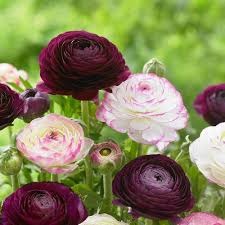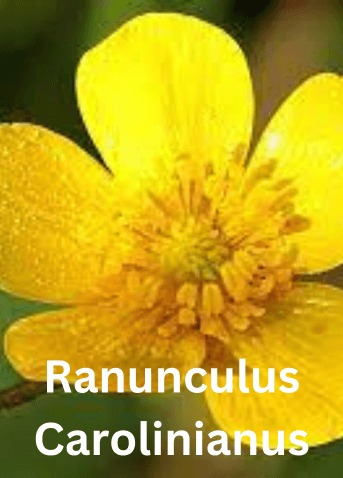Ranunculus Flowers | All you Need to Know before Buying or Growing
The gardeners who love floral arrangements, bloom, and color variations ranging from yellow to pink and red to purple and white grow Ranunculus Flowers. The name Ranunculus comes from the Latin Rana – meaning frog. They are known as frogs as they love to live near water bodies. It is planted in the fall in the warmer zone and blooms in the spring. As the color varies, it has multiple species as well. They have poppy-like blooms, perfect for beautifying bouquets and other flower arrangements.
Ranunculus Flowers (Ranunculus spp.) have the following characters. Let’s see their systematics and morphology before knowing about their propagation, growth, care, and importance.
Features of Ranunculus Flowers (Ranunculus spp.)
This table summarizes their features;
| Common Name | Ranunculus, Crow Foot, Persian Butttercups |
| Scientific Name | Ranunculus asiaticus |
| Family | Ranunculaceae |
| Plant Type | Annual, Corm |
| Plant Size | 12-16 inches |
| Soil Requirements | Loamy, Slightly Acidic with 6.0-6.5 pH, well-drained |
| Habitat | North America |
| Bloom Time | Spring |
| Flower Colours | Pink, Red, White, Yellow, Orange |
| Hardiness Zone | 4-9 USDA (United States Department of Agriculture) |
| Native Areas | Europe, Asia |
Ranunculus are grown in fall, bloom in spring,g, and are sold as beautiful flowers. After the blooming period, the flower dries, but the plant grows and stores food in the corms. Thus, it may switch from an annual to a perennial life cycle. It continues to photosynthesize. Sometimes, the plant may not flower at all due to morphological and managemental aspects. You must look for why your plant is not flowering.
The corms may continue to grow in the hardiness zones 8, 9, 10, and 11 for the next season, as these zones have mild winters. In the colder winter, the plat behaves as annuals. It takes 85-90 days to produce beautiful flowers of various colors. They are for aesthetic purposes and the food source of different pollinators and hummingbirds.
Ranunculus have long stalks and a long vase life. They can stay in the vase for 8-10 days. It is recommended to cut these flowers before they unfurl. Care for these unfurled flowers at the time of transportation, as the petals are tender and fragile. The plant is with more than 23 interesting Fun Facts you need to know.
Note: Some species of Ranunculus flowers are invasive and colonize rapidly. The weedy perennial (Ranunculus repens) forms large colonies and competes with native species.
Planting Guide for Ranunculus
How to Grow from Corms
As discussed earlier, these grow in winter in the hardiness zones from 4-11 USDA. Corms of Ranunculus are planted after the last frost. Before planting, soak the corms in the bucket at room temperature, not more than 55F. Try to replace the water every hour for 4-5 hours, and then take the corms out of the water and plant them in trays.
Fill the tray in well-drained, fertile soil with organic matter. Spread a layer of 1.5 -2 inches of soil to plant the corms. For planting, press your fingertip in the soil and make a hole. Insert 1 corm in the hole and press the soil. Cover the trays, place them in the dark, and wait for the germination.
Complete germination will take 12-14 days. The roots have developed, and after 2 weeks, the sprouted corms are ready to transplant in the field or plot. The season is perfect for them. Now, you have to consider spacing these plants. Again, pulverize the soil, make a hole, and plant corms in 2 2-inch deep holes with a distance of 9-10 inches apart. At the time of transplanting, if the weather is still cold, try to cover these corms.
How to Grow Ranunculus Flowers from Seed?
Along with the corms, these can be grown through seeds. Try to sow seeds in the trays about 10-12 weeks before the last frost. At the time of spring, they will be ready for transplantation. For growing Ranunculus flowers using seeds, follow the following steps.
- Use a soil mix or well-drained light soil to fill the trays
- Place seeds, one in each hole, and apply light water.
- Spring soil was mixed again on the seeds to cover them.
- Keep the trays in the dark with 50-55F
- Wait for 25-30 days for complete germination.
- Thinning of the plants will give better growth to the remaining plants.
- Transplant the seedlings in the plots at the onset of the spring
- Keep the distance between the plants up to 8-10 inches.

How to Propagate Through Corms?
The 3rd method of multiplying Ranunculus is propagation through Corms.
- At maturity, when the plants had turned yellow, cut the plant at the ground level.
- Dig out the corms and remove the soil
- Use a sharp blade to separate small cormels from the main corm.
- Keep the corms dry at a temperature ranging from 50 to 55 degrees F.
- Plant these corms in fall and use these pre-sown corms in spring.
- However, keep the distance at 9 inches and bury the soil deep at 2 inches.
Types of Ranunculus Flowers
Following cultivars and wild species are common.
Ranunculus Asiaticus is known as Persia Buttercup, tuberous and rooted with poppy-like flowers. The flowers are round, 2 inches in diameter. They can grow 10-12 inches in height. Flowers are of red, pink, or yellow colors. Like the small peony flowers, these blooms are 3-5 inches wide. They might be single-colored or blended with different colors.

Ranunculus Carolinianus: As the name shows, these are common in Carolina. They are also known as Carolina Buttercups. These are winter annuals with beautiful red, pink, and white flowers. They love to grow in damp places.

Ranunculus Flammula: These are known as Sagebrush Buttercups. They produce yellow flowers. They show better growth near the bank of the ponds. They have creeping stalks, and flowers grow at the tips of the stalk.

Ranunculus Repens: They are known as Creeping Buttercups. This is one of the species we have mentioned as invasive. These creeping buttercups can grow up to 12 inches. They are native to Asia and Europe. Now, they are dominating North America. Their leaves are 2 inches long. The flowers are yellowish and sometimes white.

Ranunculus Ficaria: These are called lesser celandine. They grow well in the 4-8 hardiness zones of USDA. They have dark green foliage, heart-shaped, that covers the soil as a mat. They produce white creamy flowers with variegated colors like Caladium fiesta.

Care of Ranunculus Flowers
Ranunculus are easy to grow. They require less care. The following requirements will show a clear picture.
Soil
They show that Ranunculus blooms grow better in well-drained soil with acidic pH (6.0). In the clay soil, they feel waterlogged, and their growth remains stunted. Sowing them in heavy soils is not recommended.
They perform well in damp but well-drained soils. So, they can be planted as a row plantation along the banks of a pond or water hose. This will give them wetter soil and moisture for proper growth. They love damp places.
Water
In the earlier stages, it requires frequent water. Apply frequent but smaller amounts of water to avoid waterlogging. Watering will help in sprouting and then establishment. Once the plants have been established, reduce the number of irrigation and keep the soil moist.
Fertilizer
They take 90 days to flower. In this short period, they don’t require proper fertilizers if you have planted them in well-drained, fertile soil. However, to give a boom, you can add fertilizers just before planting in the field and at the time of flowering.
Light
They are successful where the plant can face 8-10 hours of light daily. This helps in better blooming and growth. If the weather is cloudy during flowering, the blooms will be smaller and less in number.
Thinning
As we have noticed, some of the species of Ranunculus are invasive species and dominate the area; thus, there is a need to go for thinning of these species. Thinning removes weak plants from the soil, giving proper space and nutrients to the remaining plants for better growth.
FAQs
I’m Dr Qaiser Maqsood (PhD), a dedicated researcher and expert in Biological Sciences, Gardening, Bio-Diversity, Ecology, and Environmental Sciences. I’m much concerned about Environmental Pollution, Climate Change, Plantation, Gardening, and Global Warming. My passion is to explore innovative solutions in all these fields.
Be aware that we have ONLY ONE EARTH. Protect it!!






